Canon 8-15mm f/4L Fisheye Zoom
Canon 8-15mm f/4L Fisheye Zoom Performance
At 8mm and f/4, sharpness in the centre of the frame is outstanding. Towards the edges of the projected image circle, sharpness drops off gradually only reaching fair levels at this aperture. As the lens is stopped down, the clarity towards the edges of the image circle improves dramatically and between f/8 and f/11 resolution approaches excellent levels throughout the image circle.At 10mm, sharpness in the centre remains outstanding at maximum aperture, but the clarity towards the edges falls away somewhat. With the lens stopped down to f/11 sharpness towards the edges of the image circle improves to good levels.
Finally, at 15mm, there is a drop in overall sharpness levels. Although clarity in the centre of the image area is still very good, the quality towards the edges of the frame remains fairly poor at maximum aperture. As is the case with other focal lengths, sharpness towards the edges improves as the lens is stopped down, reaching fairly good levels from f/5.6 onwards.
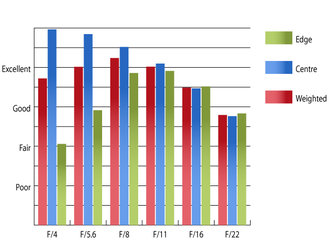 Resolution at 8mm | 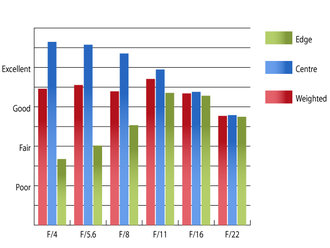 Resolution at 10mm | |
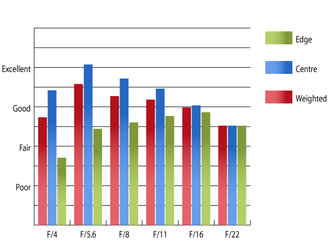 Resolution at 15mm | How to read our chartsThe blue column represents readings from the centre of the picture frame at the various apertures and the green is from the edges. Averaging them out gives the red weighted column.The scale on the left side is an indication of actual image resolution. The taller the column, the better the lens performance. Simple. For this review, the lens was tested on a Canon EOS 5D Mark III using Imatest. |
As is often the case with fisheye optics, chromatic aberrations are quite high towards the edges of the frame, and with this lens, the issue increases as the lens is zoomed in. At 15mm and f/4, fringing covers almost 2.25 pixels widths, which will most definitely be visible in high contrast areas towards the edges of the frame.
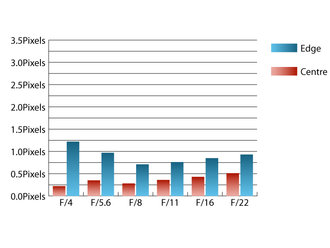 Chromatic aberration at 8mm | 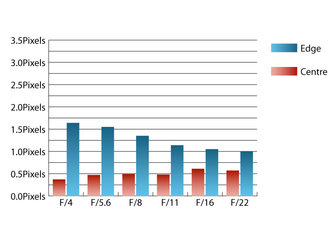 Chromatic aberration at 10mm | |
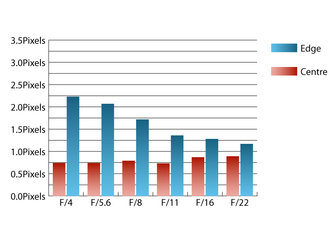 Chromatic aberration at 15mm | How to read our chartsChromatic aberration is the lens' inability to focus on the sensor or film all colours of visible light at the same point. Severe chromatic aberration gives a noticeable fringing or a halo effect around sharp edges within the picture. It can be cured in software.Apochromatic lenses have special lens elements (aspheric, extra-low dispersion etc) to minimize the problem, hence they usually cost more. For this review, the lens was tested on a Canon EOS 5D Mark III using Imatest. |
Distortion is typical of fisheye lenses, and the projection is quite even across the image area, resulting in more natural looking images than some fisheye lenses, which can leave objects near the edges of the frame looking contorted.
Due to the 180 degree field of view, it isn't possible to formally test for falloff of illumination towards the image boundaries. Illumination appears even across the image area at all apertures, although the edges of the circular image field can look a little fuzzy at apertures faster than f/5.6.
Shooting into the light isn't an issue for this lens as it is very resistant to flare and contrast holds up well too.
Add your message
Login required
Please login here or if you've not registered, you can register here. Registering is safe, quick and free.
Please login here or if you've not registered, you can register here. Registering is safe, quick and free.
photodo Stats
1102 lenses
428 MTF tests
74 in-depth photodo reviews
100+ users join each day
Help the lens community by reviewing or rating a lens today via our lens search
428 MTF tests
74 in-depth photodo reviews
100+ users join each day
Help the lens community by reviewing or rating a lens today via our lens search
Latest Lens Reviews
- Chinon 28mm f/2.8 Vintage Lens Review
- Canon EF 70-200mm f/4L IS II USM Lens Review
- Samyang AF 85mm f/1.4 EF Review
- Sigma 70mm f/2.8 DG Macro Art Review
- Samyang AF 24mm f/2.8 FE Review
- Meike 50mm f/1.7 Review
- Tamron 70-210mm f/4 Di VC USD Review
- Lensbaby Burnside 35mm f/2.8 Review
- Asahi Super Takumar 50mm f/1.4 Review
- Asahi Super-Multi-Coated Takumar 135mm f/3.5 Review
